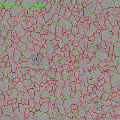Open intent classification, which aims to correctly classify the known intents into their corresponding classes while identifying the new unknown (open) intents, is an essential but challenging task in dialogue systems. In this paper, we introduce novel K-center contrastive learning and adjustable decision boundary learning (CLAB) to improve the effectiveness of open intent classification. First, we pre-train a feature encoder on the labeled training instances, which transfers knowledge from known intents to unknown intents. Specifically, we devise a K-center contrastive learning algorithm to learn discriminative and balanced intent features, improving the generalization of the model for recognizing open intents. Second, we devise an adjustable decision boundary learning method with expanding and shrinking (ADBES) to determine the suitable decision conditions. Concretely, we learn a decision boundary for each known intent class, which consists of a decision center and the radius of the decision boundary. We then expand the radius of the decision boundary to accommodate more in-class instances if the out-of-class instances are far from the decision boundary; otherwise, we shrink the radius of the decision boundary. Extensive experiments on three benchmark datasets clearly demonstrate the effectiveness of our method for open intent classification. For reproducibility, we submit the code at: https://github.com/lxk00/CLAP
翻译:用 K 中心对比学习和可调决策边界的有效开放意图分类
摘要:在对话系统中,开放意图分类是一个旨在正确将已知意图分类到各自的类别中,同时识别新的未知(开放)意图的重要但具有挑战性的任务。在本文中,我们引入了新颖的 K 中心对比学习和可调决策边界学习(CLAB)来提高开放意图分类的效果。首先,我们在标记的训练实例上预训练特征编码器,将已知意图向未知意图传递知识。具体而言,我们设计了一个 K 中心对比学习算法来学习有区分性和平衡性的意图特征,提高模型识别开放意图的泛化能力。其次,我们设计了一种可调的决策边界学习方法,具有扩张和收缩(ADBES),以确定合适的决策条件。具体而言,我们为每个已知意图类别学习一个决策边界,它由决策中心和决策边界的半径组成。然后,如果非类中实例远离决策边界,则将决策边界的半径扩展以容纳更多的类内实例;否则,我们会缩小决策边界的半径。在三个基准数据集上进行的大量实验清晰地证明了我们的方法对于开放意图分类的有效性。为了可重现性,我们在 https://github.com/lxk00/CLAP 上提交代码。



